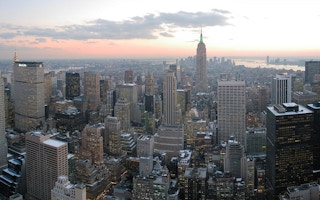Cities should try to slash the planet-warming gases pumped out beyond their own boundaries in the production of the vast quantities of goods and services they consume, researchers said.
Upstream emissions – those generated along the global production chain when cars, clothes or building materials roll out of factories around the world – are broadly on a par with those cities generate directly, said a study by scientists from Germany and the United States published by Nature Scientific Reports this week.
Focused on Mexico City, Berlin, Delhi and New York, it found that energy-intensive construction materials including cement and steel, along with transport, are among the biggest producers of emissions along the supply chain.
Buildings and transport are also the main emitters of greenhouse gases at the city level - and their carbon footprint should be lowered, said the report.
“It’s not the stuff people buy - it’s really housing and transport, and those two topics are really very much in the policy domain of local mayors,” said the study’s lead author Peter-Paul Pichler, a senior scientist at the Potsdam Institute for Climate Impact Research (PIK).
As the same activities are major sources of both direct and indirect emissions, “it might be easier than mayors think to do something about them”, he told the Thomson Reuters Foundation.
“
It’s not the stuff people buy - it’s really housing and transport, and those two topics are really very much in the policy domain of local mayors.
Peter-Paul Pichler, senior scientist, Potsdam Institute for Climate Impact Research (PIK)
The study showed almost half of Berlin’s upstream emissions are produced outside Germany - largely in Russia, China and elsewhere in the European Union.
For Mexico City, 20 percent of its emissions are generated outside the country, mainly in China and the United States.
Housing, transport and food are responsible for more than three-quarters of total upstream emissions in the four cities, the researchers found.
New York had the biggest overall upstream greenhouse gas footprint, and Delhi the smallest.
While city authorities may struggle to change the ways households consume, they can alter urban policies with a knock-on effect for emissions along the supply chain, said the study.
Building regulations could be changed to promote the use of low-carbon materials, while better insulation standards would cut the need for heating and air conditioning, potentially lowering demand for power from plants outside city limits.
Improving public transport and encouraging more cycling and walking could reduce energy-intensive car production in factories thousands of miles away, said the scientists.
And by choosing clean energy from solar or wind to run bus and subway networks, “city governments could in fact close down far-away coal-fired power plants”, they added in a statement.
Cities should also do more to measure and monitor emissions linked to consumption, they said.
“The power of cities - open, interconnected systems of great density - to tackle climate change even in times of uncertainty on the national and international level has been underestimated by both many local decision-makers and most of the international community,” said PIK researcher and report co-author Helga Weisz.
This story was published with permission from Thomson Reuters Foundation, the charitable arm of Thomson Reuters, that covers humanitarian news, women’s rights, trafficking, property rights, climate change and resilience. Visit http://news.trust.org)










